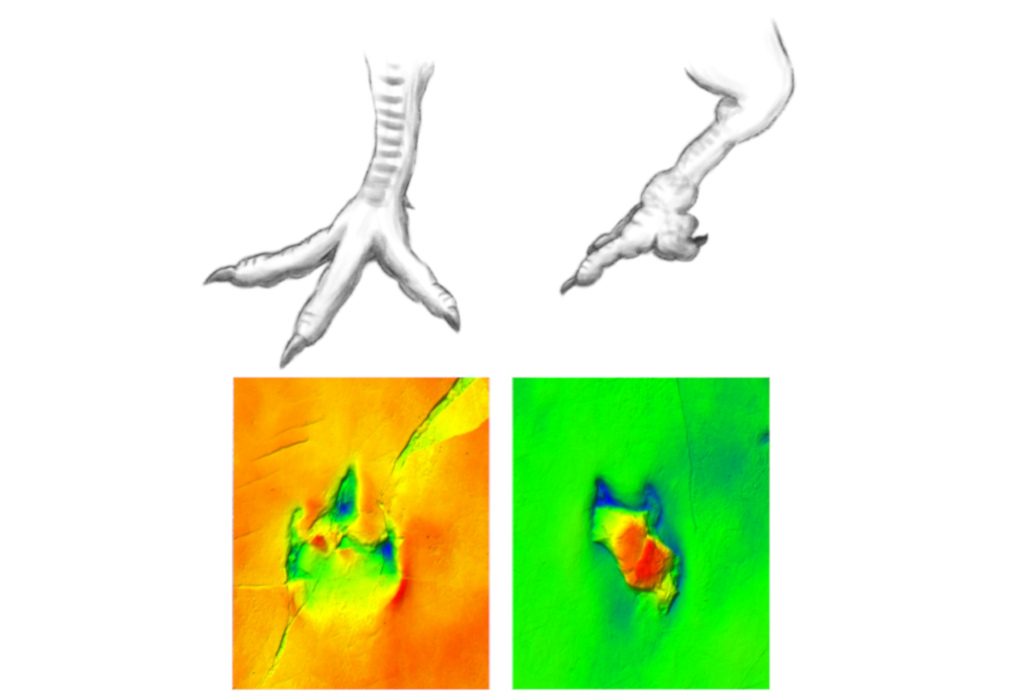Insight into Cretaceous Living Ecology: About 129 million years ago, a pathologically deformed two-legged dinosaur walked in what is now Spain, as shown by examination of a fossil track. Apparently, the animal compensates for its helplessness when walking, as is customary today for birds with injuries or deformities of the foot, as the characteristic analyzes of the path suggest.
Bones and other remains are usually of interest to paleontologists, but in addition to these fossil traces, there are also traces that come from animals of the past: in some locations around the world, the footprints of dinosaurs and other creatures attest to prehistoric times. They can provide insight into the characteristics and movement patterns of these animals. For example, body heights and running speeds were already read from the tracks. However, in the present case, the results of the study enrich knowledge of the health problems that affected dinosaurs.
asymmetric path
Paleontologists led by Angela Boscaglioni of the Autonomous University of Madrid have focused on a fossil path discovered in the sedimentary rocks of Las Hoyas, Spain. Many of the footprints are already known from the site, which originated from the dinosaurs that walked on the soft ground there about 129 million years ago. But the track, called LH-Mg-10-16, is unusual: it appears to have come from a bipedal dinosaur — although the features of the six consecutive footprints look strikingly different. So it wasn’t clear if they came from just one animal, and if so, what the special feature was. To investigate this question, Buscalioni and her colleagues scanned the footprints to obtain 3D information that allows inferences to be drawn about the shapes of the foot and the characteristics of movement.
As the researchers report, their results show that despite the distinct difference between fingerprints, only one animal tracks. The exact species of theropod dinosaur cannot be determined, but at least its size can be estimated: according to the dimensions of the footprints, it was about two meters at the waist. As the researchers reported, analyzes showed that the animal left footprints with its right foot with an average length of 44 cm, while the left foot tracked only 35 cm.
The toe was crooked
This was due to a left foot deformity: while the three toes can be seen pointing forward in the tracks of the right foot, only two are on the left. Because one of the toes was twisted backwards. As the researchers explained, this may have been the result of an injury or deformity to the foot. Other results also showed that the dinosaur apparently compensated for its disability when walking. In contrast to similar footprints of other dinosaurs, the footprints of LH-Mg-10-16 are laterally spaced. Additionally, footprint depth analyzes showed that the animal puts more stress on its healthy right foot when walking. The authors point to similarities with today’s birds: toe deformities and compensatory behaviors are known from chickens or ostriches, for example.
Additional in-situ findings indicate that the pathologically deformed theropod dinosaur appeared to walk through a soft mat of microbes covered in shallow water. He may have been on his way to a larger watering hole, the traces of which are also visible at the site. Buscalioni and colleagues concluded that LH-Mg-10-16 is particularly clear evidence of a dinosaur trajectory with pathological traits. The study also sheds light on how this dinosaur – and possibly many other dinosaurs as well – discovered ways to survive despite disease problems.
Source: PLOS, technical article: Plus One, doi: 10.1371/journal.pone.0264406

“Alcohol buff. Troublemaker. Introvert. Student. Social media lover. Web ninja. Bacon fan. Reader.”





More Stories
Up to 100 pilot whales stranded in Western Australia – Science
Huge radiation explosion from a magnetar – forschung.de
Principles and features of the folk nutritional principle